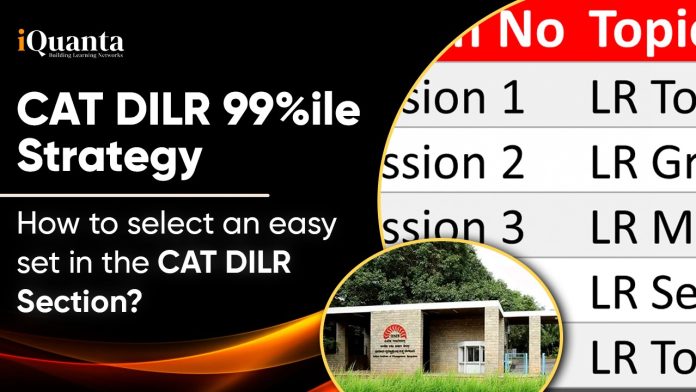DILR is often the most feared section for all categories of CAT aspirants, whether engineers or non-engineers. The main reasons are the absence of a fixed syllabus, anything can appear, and the difficulty in identifying the easy to moderate sets that the examiner includes in every CAT exam or mock test. Finding the first right set is crucial. Attempting it early, securing full marks, and then moving on can significantly boost your score. In fact, a single well-attempted set can push you above the 75th percentile. However, the real challenge is spotting that easy set. In this blog, we’ll discuss how to identify easy sets in the CAT DILR section.

Why is Right Set Selection Important in the CAT DILR section?
First, the examiner is bound to include at least one easy set in the DILR section to balance the difficulty level for candidates from different backgrounds and ensure fair relative performance. If not an easy one, there will at least be a moderate set, which can be solved within 10 minutes if approached correctly.
Second, choosing your first set based on your strengths and your judgment of its difficulty can boost your confidence. Starting strong helps build momentum and reduces mental pressure for the rest of the section.
Third, even attempting and correctly solving just one DILR set can fetch you around the 75th percentile. However, to push your score towards the 99+ percentile range, you’ll need to attempt a few more sets or questions with accuracy.
How to select a set in the CAT DILR section?
Before we begin, it’s important to understand that two popular narratives exist in the CAT preparation circle.
The first is a traditional, widely suggested approach. However, the issue is that not everyone finds it easy to grasp, and many aspirants often feel lost while trying to implement it in real exam situations.
The second is a proven, practical approach developed by iQuanta’s top DILR faculty — experts who’ve consistently solved DILR problems for years and secured 99+ percentiles in CAT multiple times. This strategy has been successfully used by over 500 iQuanta CAT toppers to cross the 99+ percentile mark.

| Parametres | Traditional and Old Approach 🙁 | Smart and Topper’s Approach 🙂 |
| Idea | This approach recommends that you first read an entire random set carefully, take a deep breath, and then assess whether you can solve it based on your familiarity with similar sets you’ve practiced before. | This approach recommends carefully reading all the sets before attempting any. Then, pick the one with fewer constraints and a solving process you clearly understand.While consistent practice is essential, there are a few smart tactics to keep in mind. |
| Tips | Generic Tip:It advises prioritizing LR-based sets, as Logical Reasoning is skill-based and improves with consistent practice. Tackling an LR set early can energize your fresh, focused mind during the exam and help you arrive at solutions quickly. | Specific Tips:Actively look for sets with minimal constraints, easy calculator-based questions, a straightforward approach, and one where you can easily visualize the solving process. In the CAT exam, you never know whether LR or DI will be tougher — so build the skill to identify your strengths and decide whether you’re more comfortable with DI or LR on the spot. |
| Time | Longer time to solve the first set than it actually requires. | The initial reading of all sets takes time. But, take your time choosing the first set and mark the other sets you are confident you can attempt, leading to less overthinking. |
| Problem | The issue is that not everyone can effectively grasp this method, and many aspirants often freeze or go blank while trying to implement it in the exam. | The good thing is, this approach becomes better with regular live classes at iQuanta, where students can freely ask doubts, discuss solutions, and understand the reasoning behind every step without hesitation. |
DILR Set Selection Tips
Tip 1: Choose the set with constraints of around 2-3. If the sets have more than 3 constraints, you may avoid it to save time.
Better to choose a circular arrangement with 8 persons, their shirt colors, and city than an arrangement set of 10 people in a building, their shirt colors, favourite fruit, birthdays, and apartment numbers.
Tip 2: Do not fear complex calculations. Read the questions carefully and save all the data points you solve at each step.
If they are asking about percentage change rate, you get the percentage change in numbers and saved it aside. So, that if they are asking difference of percentage change between two elements you can quickly get the already calculated data point.
Tip 3: If possible, avoid DILR sets with mixed concepts. A trend in CAT 23 and CAT 2024, DILR sets are becoming complex with mixed concepts like arrangement & ranking, table & graph. Mathematical reasoning & table, and many more. Still, this is not a fixed tip. If you feel it is easy and familiar, then go for it.
Tip 4: No matter what, this is the only tip that will be your friend during your exam. Maintain cool, calm and focus. Simple yet most powerful tip.
Join the Largest CAT Preparation Community in India

How to get the Ultimate LRDI Guidebook?
We’ve shared all the essential tips and strategies above. But we understand many aspirants still wonder how to practically apply them, especially how to decide whether a DILR set is worth attempting.
To address these common worries, iQuanta launched LRDI Essentials, the first dedicated LRDI course for those aiming to strengthen their foundation or break into the 99+ percentile in CAT 2025.
This course not only covers the basics but also equips you with customized tricks and approaches for every type of LRDI set, ensuring you spend less time interpreting sets and more time solving them.
Course Highlights:
- 10 videos on Arrangements
- 5 on Distribution
- 5 on Cubes
- 6 on Games & Tournaments
- 5 on Venn Diagrams
- 3 on Routes & Networks
- 3 on Binary Logic
- 3 on Selection
- 5 on high-value Puzzles
A complete toolkit for every aspirant targeting 99+ percentile in LRDI — with smart practice, efficient strategies, and maximum returns for your efforts.


